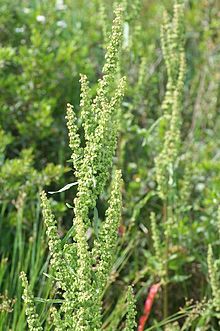- Rumex crispus
-
Rumex crispus Scientific classification Kingdom: Plantae (unranked): Angiosperms (unranked): Eudicots (unranked): Core eudicots Order: Caryophyllales Family: Polygonaceae Genus: Rumex Species: R. crispus Binomial name Rumex crispus
L.Curled Dock (Rumex crispus), also known as Curly Dock, Yellow Dock, Sour Dock, Narrow Dock, sometimes as "narrow-leaved dock" (which properly refers to a variant of Sorrel), and ambiguously as "garden patience", is a perennial flowering plant in the family Polygonaceae, native to Europe and Western Asia.
The mature plant is a reddish brown colour, and produces a stalk that grows to about 1 m high. It has smooth leaves shooting off from a large basal rosette, with distinctive waved or curled edges. On the stalk flowers and seeds are produced in clusters on branched stems, with the largest cluster being found at the apex. The seeds are shiny, brown and encased in the calyx of the flower that produced them. This casing enables the seeds to float on water and get caught in wool and animal fur, and this helps the seeds to spread to new locations.[1] The root-structure is a large, yellow, forking taproot.
Curled Dock grows in roadsides, all types of fields, and low-maintenance crops. It prefers rich, moist and heavy soils.
Distribution
Curled Dock is a widespread naturalised species throughout the temperate world, which has become a serious invasive species in many areas, including throughout North America, southern South America, New Zealand and parts of Australia. It spreads through the seeds contaminating crop seeds, and sticking to clothing. It is designated an "injurious weed" under the UK Weeds Act 1959.[2] It is often seen in disturbed soils at the edges of roadsides, railway beds, and car parks.
Uses and toxicity
It can be used as a wild leaf vegetable; the young leaves should be boiled in several changes of water to remove as much of the oxalic acid in the leaves as possible, or can be added directly to salads in moderate amounts.[3] Once the plant matures it becomes too bitter to consume. Dock leaves are an excellent source of both vitamin A and protein, and are rich in iron and potassium. Curly Dock leaves are somewhat tart due to the presence of high levels of oxalic acid, and although quite palatable, this plant should only be consumed in moderation as it can irritate the urinary tract and increase the risk of developing kidney stones.
The roots have also been used medicinally as an astringent, tonic, and laxative. Compounds contained in the plant's roots have been clinically verified to bind with heavy metals such as lead and arsenic and expel them from the body by stimulating biliary function in the liver. The plant is considered a highly effective blood cleanser and is used by herbalists to assist the body in eliminating heavy metals and to treat other hepatic disorders. [4] [5][dubious ]
References
- ^ Richard H. Uva, Joseph C. Neal and Joseph M. Ditomaso, Weeds of The Northeast, (Ithaca, NY: Cornell University Press, 1997), Pp. 286-287.
- ^ http://www.defra.gov.uk/farm/wildlife/weeds/
- ^ Lee Allen Peterson, Edible Wild Plants, (New York City: Houghton Mifflin Company, 1977), p. 154.
- ^ A Modern Herbal: Docks
- ^ Edible and Medicinal Plants of the West, Gregory L. Tilford, ISBN 0-87842-359-1
Edible and Medicinal plants of the West, Gregory L. Tilford, ISBN 0-87842-359-1

This Polygonaceae article is a stub. You can help Wikipedia by expanding it.

